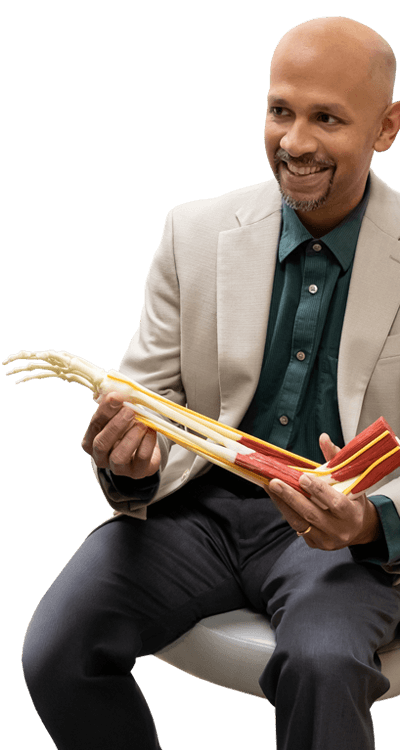Baby boomers are changing what retirement looks like. Compared to past generations, they’re keeping busy. Just how busy? According to an analysis of activity-tracker data by researchers at Johns Hopkins, today’s 60-year-olds move about as much as 19-year-olds—that is, unless something, such as chronic severe knee pain and mobility challenges, makes it too hard to keep active
But settling for more sedentary golden years isn’t the only choice. The newest knee replacement surgery techniques and technologies are helping more and more older adults regain function and stability so they can perform daily activities again without the burden of significant pain.
If you’re considering a procedure to replace a damaged knee joint, keep reading to learn about the history of knee arthroplasty and the benefits of modern solutions like the Jiffy Knee replacement approach, Stryker’s Mako SmartRobotics surgery system and Triathlon Total Knee implants, and Zimmer Biomet’s Persona IQ “Smart Knee” implant for measuring post-operation range of motion. Plus, get insights from Dr. Clayton Strong, a five-star-rated knee specialist and one of Henry Community Health’s experienced orthopedic providers.
A timeline of the evolution of knee replacements
The following list includes a few brief milestones in the history of knee arthroplasty that paved the way for today’s most patient-friendly techniques and technologies.
Pioneering first steps & discoveries
1861: Sir William Fergusson performed the first known arthroplasty (replacement) of the knee to improve the motion and stability of a patient with arthritis.
Late 1800s–early 1900s: During this era, surgeons pioneered new techniques to alleviate arthritis pain and improve joint function. Early procedures utilized tissue, such as fat or fascia, to cushion the knee, while innovators also experimented with the first artificial implants. In 1890, Dr. Themistocles Gluck attempted one of the earliest knee replacements using an ivory-hinged prosthesis, while others, such as John B. Murphy, Vittorio Putti, and Willis C. Campbell, refined approaches to soft-tissue grafting. These efforts laid the groundwork for the development of reliable joint replacement surgery.
1940: The late 1940s saw some of the first post-war efforts to replace the knee joint entirely, moving beyond resurfacing procedures. In 1947, the Judet brothers of Paris introduced an acrylic hinged knee prosthesis, pioneering one of the earliest true total joint replacements. Two years later, in 1949, Italian surgeon L. Magnoni reported success with a similar acrylic hinged design, marking the start of a short-lived era of polymer-based hinges in knee arthroplasty.
1950: The early 1950s marked the first wave of experimental total knee replacements, laying the foundation for modern prosthetic design. In 1951, Swedish surgeon Börje Walldius performed the first implantation of his fixed-hinge total replacement endoprosthesis. In 1953, Walldius advanced his design by shifting from acrylic and steel constructs toward all-metal prostheses as materials improved. That same year, in the United Kingdom, Leslie Gordon Percival Shiers introduced his own stainless-steel hinged knee, furthering parallel innovation.
1968–71: Inspired by the work of Sir John Charnley (a total hip replacement pioneer), Dr. Frank H. Gunston is credited with having performed the first total knee arthroplasty (TKA), implanting the first high-density polycentric knee using polymethyl methacrylate cement fixation. Dr. F.H. Gunston published his article “Polycentric Knee Arthroplasty: Prosthetic Simulation of Normal Knee Movement” in 1971.
1977–84: Frederick F. Buechel, MD, and Michael J. Pappas, PhD, introduced the New Jersey LCS mobile-bearing total knee, pioneering rotating platform meniscal bearings to reduce contact stresses and wear.
1997: The first computer-navigated (imageless) total knee arthroplasty was performed in France.
Breakthroughs & the development of next-generation solutions
2006: Jiffy Knee—a subvastus, quad-sparing knee replacement approach—was developed by Dr. Manish Patel for clinical use. His trademarked technique focuses on preserving soft tissue to help reduce early pain and speed up initial rehabilitation.
2015: Stryker’s expanding robotic-arm assistance tool, Mako, received FDA clearance for total and partial knee surgeries.
2017: The FDA extended clearance to cementless Mako Total Knee Arthroplasty using porous Triathlon Tritanium components.
2021: Zimmer Biomet’s Persona IQ has earned De Novo authorization, making it the first “smart knee” to collect and stream objective post-operative data, including step count, walking speed, and range of motion, from an implanted tibial extension.
Modern options for replacing knee joints
Today, there are a lot of options for knee replacement surgery, but that wasn’t always the case. Thanks to over a century of steady progress, many patients are now also experiencing better outcomes from knee arthroplasty procedure.
Here’s a closer look at some of the incredible breakthroughs in medicine (such as quad-sparing knee replacement techniques, robotic planning for better alignment, and “smart” implants for more personalized recovery protocols) that have helped to make these noteworthy results possible.
Benefits of today’s knee replacement solutions
What makes the newest knee replacement surgery options different is that these techniques and technologies come together to help surgeons give patients the best possible outcomes. Modern muscle-sparing approaches aim to protect the quadriceps so patients can use their new knees right away. “Patients’ quad function returns nearly immediately,” says Dr. Strong.
Robotic assistance can help surgeons execute plans with haptic guidance and defined boundaries, which supports precise placement of components. While robotics can improve planning and execution, short-term functional outcomes versus conventional total knee arthroplasty techniques aren’t consistently superior across studies. Precision matters in knee replacement, and strong fundamentals, combined with patient consistency during rehabilitation, still drive results.
Alignment philosophy is often debated. Dr. Strong’s take is practical: “There’s no hard evidence that any alignment philosophy is better for patients. The X-ray may look different between different alignment methods, but outcomes won’t differ.” He uses mechanical alignment with soft-tissue balancing because, he notes, implants are “engineered and tested in a mechanically aligned position.
There’s no hard evidence that any alignment philosophy is better for patients. The X-ray may look different between different alignment methods, but outcomes won’t differ.
Dr. Clayton Strong
HCH’s 3 newest knee replacement surgery options
At Henry Community Health, our orthopedic team continually investigates and receives training to offer patients the latest technologies and techniques for knee replacement. Here’s a closer look at three of the most-requested solutions and newest knee replacement surgery options we have available.
Jiffy Knee™ replacement: The minimally-invasive pioneer
With Jiffy Knee, you get the best of both worlds: an approach that’s still “new” in the history of knee arthroplasty but a technique that’s been around enough time to be considered a proven safe option for a faster recovery process because—instead of splitting the quadriceps tendon—a surgeon using the Jiffy Knee replacement approach works under the vastus to protect the extensor mechanism.
That said, even when using the Jiffy Knee method, this type of knee replacement surgery remains a major procedure. “I never call Jiffy ‘minimally invasive,’” says Dr. Strong. “I still make an incision about as long as is made with a traditional split, but the difference is that with the Jiffy Knee, the incision is on the side of the knee. It’s a minimally traumatic, muscle-sparing approach.”
Patients can typically use their new knee immediately and start therapy as soon as the anesthetic wears off (about 1.5–2 hours after surgery). “We make sure you can do stairs if you’re going home the same day. If you stay overnight, therapy is more aggressive the next day, then continues at home.”
Mako total knee replacement: Robotic-assisted precision
Before a surgery that will use Mako, you’ll get a CT scan that will create an image from which a 3D model of your knee will be created. This helps your surgeon map out sizes and positions in advance.
Then, on the day of the operation, the team uses Mako’s robotic tool to prepare your knee and place the implant. Your surgeon is at the controls the entire time and can make adjustments if something looks better for your knee once they’re in the joint.
Persona IQ: The smart knee technology
Persona IQ is essentially a small “smart” stem that’s added to a standard knee implant. After surgery, that stem quietly records how your knee is moving and sends the information to a base station in your home. From there, the data appears in the mymobility app so you and your care team can see real progress.
Most patients who choose this option are looking for more precise feedback during recovery and like having an easy way to track their progress between appointments. Your surgeon and physical therapist will also use the information from the app. It can help them know when to slow things down (if the data indicates swelling spikes) and even show when it’s safe for you to add back more movement.
Who benefits most from these newest knee replacement surgery techniques and technologies?
Dr. Strong’s rule of thumb is simple: If you’re skipping things you want to do every day because of your knee, replacement usually helps. If you can still do nearly everything and you’re chasing marginal gains, waiting is reasonable.
The perfect patient is the one who is miserable and has tried all non-operative treatments and not gotten relief, so they go in physically and emotionally prepared,
Dr. Strong
Here is a rundown of who the best candidates are for each of the three newest knee replacement surgery options available at HCH:
- Jiffy Knee is often suitable for individuals who want to use their quadriceps immediately and start moving with therapy right away.
- Mako is helpful when your surgeon wants added guidance to keep the plan precise.
- Persona IQ suits patients who like seeing recovery data alongside standard follow-ups.
What to expect at a knee replacement consultation
At your joint replacement consultation appointment, be prepared to talk to your knee surgeon about what “better” looks like for you at six weeks and six months. You’ll also be asked to describe your medical history and what support you may have during the recovery process.
From your knee surgeon, expect honesty about pain and pacing. “As a surgeon, it’s important to set expectations up front. I let my patients know that Jiffy Knee replacement, even though it’s less painful, will still cause pain, and that doing therapy after is going to be a lot of work. Knowing this helps people push through the tough parts,” says Dr. Strong.
You’ll also hear details about how the therapy process typically works. The goal is to make that work start sooner and stay on track without overdoing it.
Tips for finding a great knee replacement surgeon
When comparing surgeons, ask about their annual volumes for total knee replacements, infection and revision rates, and how often the hospital team performs arthroplasties.
Experience—both the surgeon’s and the facility’s—matters.
You want to choose a specialist who does 50–100 a year. With surgeons who do fewer surgeries than this, your risk of complications goes up
Dr Strong
You’ll also want to ask about infection and revision rates. Ideally, your knee replacement surgeon and his team will perform this type of procedure routinely and have a strong reputation for rarely making errors in the operating room.
Find pain relief with one of the newest knee replacement surgery options
Whether your path is muscle-sparing Jiffy Knee, robotic-assisted total knee arthroplasty, Persona IQ, or a conventional approach, the plan your knee surgeon recommends should fit your goals and include clear expectations. “We’re teachers, not technicians,” Dr. Strong says. “Listening and setting expectations up front sets patients up for success.”
It’s so important to genuinely listen when patients tell you what they need and take time to answer all their questions. I treat my patients how I would want to be treated and how I’d want a doctor to care for my loved ones.
Dr. Clayton Strong
Choose HCH for close-to-home, knee arthroplasty
At Henry Community Health, our orthopedic physicians offer the newest knee replacement surgery options to help patients find pain relief and regain mobility.
With a wide range of the latest advanced solutions as well as coordinated rehab, you can feel confident that you’ll receive the best available personalized care when you choose HCH’s team to replace your knee.
If you’d like to know whether Mako, Persona IQ, or a quad-sparing knee replacement is right for you, schedule a consultation with one of our joint arthroplasty experts. We’ll answer your questions and help you determine which solutions offer the best potential match for your ideal outcome.


